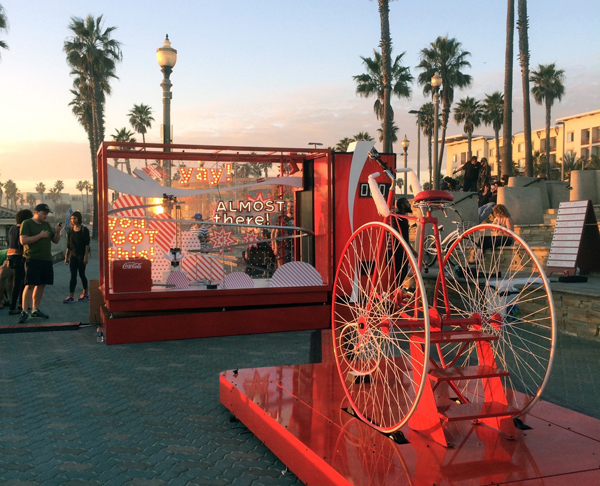
Pictured: The Happy Cycle at sunset In January 2014, Wieden+Kennedy and Coke headed to California. The goal here was to add Coke's voice to the health conversation by showing people first hand what it takes to burn the 140 calories found in a 12 oz can, and how that can actually be fun. We turned an antique replica Double Eagle into an exercise bike and inserted the calories burned into a one-of-a-kind Coke machine. For every 20 calories burned, we moved a Coke one step closer to dispensing by way of robot arms, auger lifts, automated roller skates, and more. At the 140 mark, the can was launched from the labyrinthine contraption, into the Coke machine, and out of the dispenser. The Coca Cola Happy Cycle We had a full day of takers and, despite some skepticism from resulting reviews, everyone who rode this bike had a total blast doing it. Some people even got competitive with it. This was probably my favorite project ever to "test and debug". It's such a fun ride. In addition to the obvious machinery and robotics which appear in the video, there are some less obvious lights, bells, and sensors that round out the details of the experience. None of which are digital. On the bike, we built a Hall effect sensor out of a security door alarm. We also entered the wide and varied world of load cells to weigh the subject. After a lot of research and calibration, we built a system which could, quite accurately, read a rider's speed and weight to work out their caloric burn rate. Inside the Coke machine was a chain of shooting gallery style mechanical bots, bells, lights, a fog machine, a massive analog seven-segment display, and at the end -- an actual hacked Coke machine. Truth be told, the wind sock guy (ahem... "air dancer") was hand operated. Mainly because we didn't get it until the day of and didn't have time to test automating it. Cinder lived at the center of it all. We used Cinder-Asio extensively to operate a network of Arduinos. This Cinder server of sorts read the data from the bike's sensors and did all the heavy lifting to sort out an accurate calorie count. It used that info to trigger steps in the machine. It could also emulate any step in the process for testing. We even had a ride simulator to test out the machine before we could get it in the same room as the bike. We developed a nice data filter system in the process. Regardless of how much a person bounced around on the bike or how noisy the signal was, we were able to nail the weight with about "bathroom scale" accuracy. Unlike a bathroom scale, though, it was able to just run continuously. It picked out an accurate weight quickly (<2s), improved upon it over the next few seconds, and held it for the rest of the ride. The experience itself was awesome. We set all this up totally unannounced (to the public). The signup sheet filled immediately and we had a great audience. I was surprised to see how many people turned this thing into basically their whole day at the beach. It really was just happiness all around for everyone who participated, even the staff (myself included) who were setting it up under the cover of darkness until 5am the night before. Good times.

